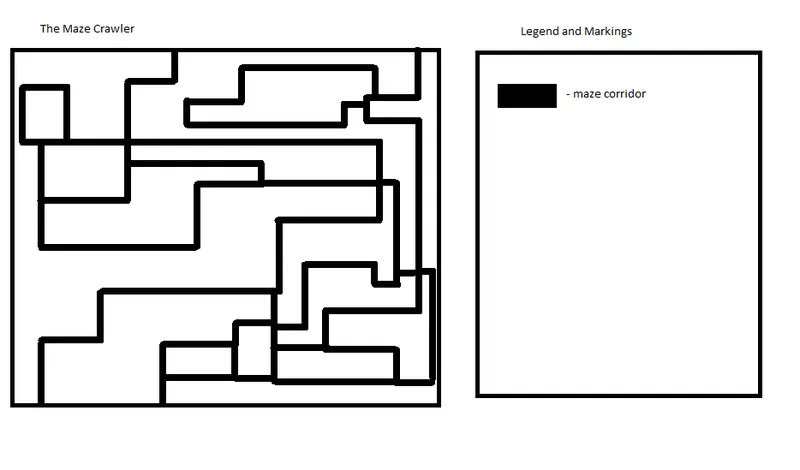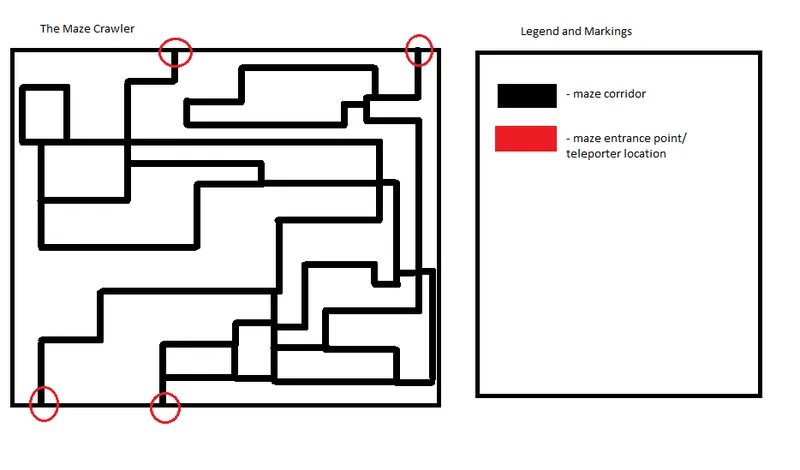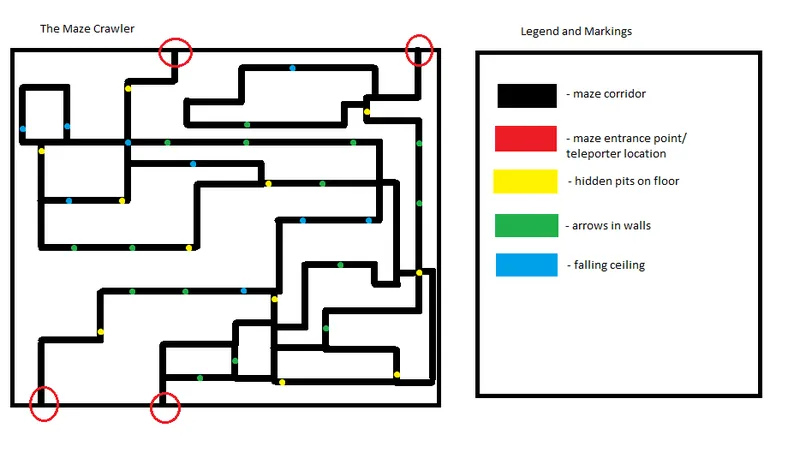In this article we are going to perform some basic Game Design for a simple five stages maze crawler. Let's start with the obvious question - what is this maze crawler game going to be and how are we going to go on to develop it? The goal in the game is going to be to get from point A to point B in order for you to finish the level. Along the way you are going to meet all sorts of weird traps that are going to try to stop you from fulfilling your goal. Another thing to note is that a good maze crawler does not repeat itself too much. That's to say that we should switch the player's starting and finishing point on a random basis. We are going to discuss all of these concepts further down the article.
Main Concept
Let's start right here. Nothing can truly be achieved if you do not have a good planning base. Firstly, we need to define the exact objective of the game. We've already determined that we should be able to get from point A to point B to complete the game, however that alone is just not very appealing. Let's say that our player is spawned at a certain point in the maze. From that point you would need to find a teleport in order to escape the current location you are in. Now ... in the current article we are talking about a very very small game, mostly due to the fact that this is all aimed towards beginners. We are going to design 5 such levels. However, the lack of quantity should never be a reason for neglecting the replay value. This is one of the most important elements of a good game and in turn - good Game Design. If you have good replay value, you have a good game (at least in the general number of cases). So how are we going to make this small game have any replay value at all? Well ... to start off, we are going to have different locations for the player and the teleporter inside the maze level itself. The number of random locations is not going to be too big in this example in order to avoid confusion but we'll get to that shortly. What I want to say here is that along the lines of this article we are going to implement other (more) elements that increase replay value in a vastly different way then having a random spawn position. Now, before we can get to actually do something more serious, I'm going to put in here the basic schema of the maze so we can take a look at what it's supposed to look like. Further chapters are going to deal with corridor design and other stuff along these lines. This schema is going to be that of the very first level.

As you can see in the picture, we have four entrances and a couple of "endless loops" within this maze. Hardly a challenge, yet we are going to turn it into one. As this article progresses we are going to add random spawn points, traps and many more features. We are also going to go over designing such a level and making it harder and harder in terms of logistics.
Random Spawning points
Now, let's take a look at a modified version of the first level of the maze crawler that we talked about in the previous section.

As you can see, in the image we have the four entrance points. They are going to serve not only as a beginning location but also they are going to be our teleporter points. And this is how things are going to go - in this design we should have only one entrance point and only one teleport. On each of the four locations we are going to place a game object as a marker. If you are using Unity3D for example, I would suggest using a small cube and from there removing its mesh. Each marker is going to have an id from 1 to 4. From this point on, firstly we are going to instantiate the entry point in one of the four locations by generating a random number in the 1 - 4 range. Then we will cache the id. After that we will instantiate the teleporter. This is going to be done in the same way as the start location, except for the fact that we are going to check the random id. If it is the same as the cached, we will get another random id. And of course there are far better technical solutions then this but they are all in the technical field and we are not going to overload the article with such things. So this is how we generate the random starting point and the teleporter. Now time to do something more interesting.
Enter the Traps
What's a good maze without some traps to make your life miserable? In our simple maze, we are going to define three types of traps - hidden pits on the floor, arrows shooting out of the walls and stalactites falling from the ceiling. Now, let's take a look at some trap placement in the following picture.

As you can see here, we have the pits placed on turns or on corridor entry, the arrows are placed in long corridors along with the falling ceiling. You can evade the traps on the floor by jumping and the arrows and stalactites can be evaded through running. However this doesn't seem too hard, does it? The player will eventually learn where you've placed your traps and thus - your maze no longer poses a threat to the in-game character. From that point on you lose your replay value. We have to fix that. We will do that by implementing something that we are actually familiar with. Random trap placement. Yes, you heard me - random trap placement. We will do this in a similar way as the entry point and the teleporter. However, a note to the technical guys - here we have a big array of elements to spawn. A more sophisticated exclusion mechanism is in order. On a side note as well, here you are going to have to be careful where you place your traps inside the corridor. You don't want to get in a situation where the maze becomes too hard or damned near impossible to finish. But we'll get to that later on when we talk about corridor building. Good, now we have the randomized traps. However is that really enough? No, it isn't. Let's add a new feature to the mix.
The All-mighty Timer
Let's make things intense. A countdown timer. Not just a countdown timer but a best time as well. So how do we do this? Well, the timer has to have enough time to just find the teleporter at a regular gaming pace. However, the less time you spend in finding the teleporter, the more you would move up in high score. If you can't find the teleport in time, well, you kick the bucket and get a nice "Game Over" message. Now, a reasonable question would be how to choose your time? What exactly should your regular gaming pace be? Well, this is something that you are going to have to find out for yourself - by playing your own maze. A lot. A tip I can give you here is some reverse engineering. Before actually implementing the countdown timer, do a timer that counts up the time you need to complete the maze. After tracking your time, both normal paced and best time, you can calculate what you are going to have to put in your final product.
Corridors and Corridor Loops
Now ... an interesting question would be how to position your corridors and how to structure the maze itself. The first thing is, you have to make the corridors intersect with each other in such a way that it would confuse the player. You have to make him doubt if he's been through this path before or not. With the traps and the countdown, the player really doesn't have all that much time to think about what's going on. That's your chance to confuse him even further. A good thing to do here is to create a loop through the corridors with at least two similarly positioned exits. If you can manage to link at least one of the exiting corridors to the same loop again, then your players are in for a treat. This really is up to you and your creativity. You can do whatever you like with this.
Difficulty Increase
And last but not least, we have a 5 level maze, yet we've only discussed how to make the first one. So ... how can we make things even harder? Well, here is a short list of some of the things you can do here:
- For level 2 we should do something simple. Remaster the corridors and add more traps.
- For level 3 we should add two more entry/teleport points. Remaster the corridors and add more traps.
- For level 4 we should remaster the corridors and add a lot more traps. We should decrease the countdown time as well, however it shouldn't be drastic.
- For level 5 we can try to only remaster the corridors and trap positions, yet decrease the countdown timer ... a lot. This should be made really hard.
This is just an example. It's really up to your creative ideas at this point.
Interesting Points
This is a basic overview of what a maze crawler game should look like, at least in my opinion. There are a lot of things you can do here and many stuff you can blend in. Be creative.
Conclusion
The Game Design of a Maze Crawler game is something that bends itself to simple rules and a lot of logistics. Experimenting is key to a successful desgn.
Article Update Log
15 May 2013: Initial release






